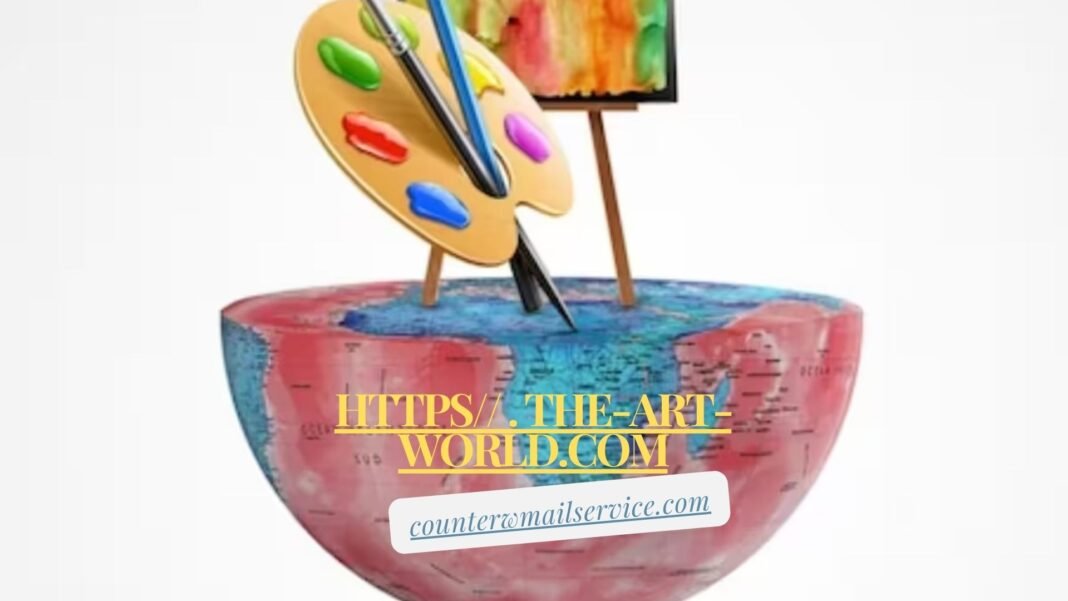Introduction
The https// . the-art-world.com is a vast and intricate network that encompasses a wide range of creative expressions, from traditional painting and sculpture to contemporary digital art and performance. Understanding the art world requires an appreciation of its history, the various movements and styles that have emerged over centuries, and the impact it has on culture and society. This comprehensive guide will delve into these aspects, offering insights into the key elements that define the art world today.
Importance and Relevance in Contemporary Society
https// . the-art-world.com has always played a crucial role in human society. It serves as a medium for self-expression, a reflection of cultural values, and a tool for social and political commentary. In today’s rapidly changing world, art remains relevant as it adapts to new technologies and responds to global issues, continuing to inspire, challenge, and provoke thought.
Historical Development
Ancient Art and Its Significance
Ancient art, dating back to prehistoric times, includes cave paintings, sculptures, and artifacts that provide valuable insights into early human civilization. These works often held religious or ritualistic significance and were integral to the communities that created them.
Renaissance and the Rebirth of Classical Ideas
The Renaissance, spanning the 14th to the 17th centuries, marked a revival of classical learning and artistic expression. Artists like Leonardo da Vinci and Michelangelo sought to capture the beauty of the natural world and human form with unprecedented accuracy and emotion, laying the groundwork for future artistic endeavors.
Modernism and the Break from Tradition
Modernism emerged in the late 19th and early 20th centuries as artists began to reject traditional forms and techniques. Figures like Pablo Picasso and Wassily Kandinsky explored abstraction and new perspectives, pushing the boundaries of what art could represent.
Postmodernism and Contemporary Movements
Postmodernism, beginning in the mid-20th century, questioned the very nature of art and its role in society. Contemporary movements continue to evolve, incorporating diverse media and exploring themes such as identity, politics, and technology.
Themes and Styles
Realism and Its Focus on Accurate Representation
Realism, emerging in the 19th century, aimed to depict subjects as they appear in everyday life without idealization. Artists like Gustave Courbet and Jean-François Millet focused on ordinary people and scenes, highlighting the beauty and struggles of the real world.
Impressionism and the Capture of Light
Impressionism, led by artists such as Claude Monet and Edgar Degas, broke from traditional techniques to capture fleeting moments and the effects of light. This style emphasized brush strokes and color over detailed form, revolutionizing the art world.
Abstract Art and the Departure from Reality
Abstract art, pioneered by artists like Wassily Kandinsky and Piet Mondrian, abandoned realistic representation in favor of shapes, colors, and forms. This movement allowed for greater emotional expression and conceptual exploration.
Surrealism and the Exploration of the Subconscious
Surrealism, led by Salvador Dalí and André Breton, sought to unlock the unconscious mind and explore dreams and irrationality. Surrealist works often feature bizarre and fantastical imagery, challenging viewers to look beyond the surface.
Techniques Used
Oil Painting and Its Dominance in Western Art
Oil painting, developed in the early Renaissance, became the dominant medium in Western art due to its versatility and durability. Artists could create rich textures and vibrant colors, allowing for detailed and lifelike representations.
Watercolor and Its Versatility
Watercolor painting, known for its fluidity and transparency, has been used for centuries across different cultures. This technique is valued for its spontaneity and ability to capture delicate details and atmospheric effects.
Sculpture Materials and Methods
Sculpture has been a fundamental form of artistic expression since ancient times, utilizing materials such as stone, bronze, and wood. Techniques have evolved from classical marble carving to modern installations using mixed media and found objects.
Printmaking Techniques and Processes
Printmaking encompasses various techniques, including etching, lithography, and screen printing, allowing artists to produce multiple copies of a single work. This art form has played a significant role in the dissemination of images and ideas throughout history.
Notable Works
Leonardo da Vinci’s “Mona Lisa”
The “Mona Lisa,” painted by Leonardo da Vinci in the early 16th century, is renowned for its exquisite detail and mysterious expression. This masterpiece exemplifies Renaissance ideals and continues to captivate audiences worldwide.
Vincent van Gogh’s “Starry Night”
Vincent van Gogh’s “Starry Night,” created in 1889, is celebrated for its emotional intensity and swirling, vibrant colors. This iconic work captures the artist’s turbulent state of mind and innovative approach to painting.
Pablo Picasso’s “Guernica”
“Guernica,” painted by Pablo Picasso in 1937, is a powerful anti-war statement depicting the horrors of the Spanish Civil War. This monumental black-and-white canvas remains one of the most moving and significant works of the 20th century.
Jackson Pollock’s “No. 5, 1948”
Jackson Pollock’s “No. 5, 1948” is a quintessential example of Abstract Expressionism. Known for his drip painting technique, Pollock’s work embodies the spontaneous and dynamic nature of this movement.
Cultural Impact
Art as a Reflection of Societal Values
Art often mirrors the values, beliefs, and issues of its time. From the religious iconography of the Middle Ages to the social commentary of contemporary art, it serves as a record of human history and cultural evolution.
The Role of Art in Political Movements
Art has been a powerful tool for political expression and activism. From Francisco Goya’s depictions of war atrocities to the graffiti of Banksy, artists have used their work to challenge authority and inspire change.
The Influence of Art on Popular Culture
Art influences and is influenced by popular culture, creating a dynamic interplay between high art and mass media. This relationship is evident in the works of Andy Warhol and the rise of street art, blurring the lines between traditional and contemporary forms.
Art and Its Impact on Technology and Media
The advent of digital technology has revolutionized the art world, enabling new forms of creation and distribution. Digital art, virtual reality, and social media platforms have expanded the reach and impact of artistic expression.
Contemporary Scene
Leading Contemporary Artists
Today’s art world is shaped by a diverse array of artists pushing boundaries in various media. Figures like Ai Weiwei, Yayoi Kusama, and Banksy continue to challenge conventions and address global issues through their work.
Major Art Movements Today
Contemporary art encompasses numerous movements, including Minimalism, Conceptual Art, and Street Art. These movements reflect the ongoing evolution of artistic expression and the exploration of new ideas and mediums.
The Role of Digital Art
Digital art has emerged as a significant force, with artists using software, digital tools, and online platforms to create and share their work. This medium allows for innovative approaches and has democratized access to art.
Street Art and Its Growing Influence
Street art, once considered vandalism, has gained recognition as a legitimate form of artistic expression. Artists like Banksy and Shepard Fairey have brought street art into the mainstream, using public spaces to convey powerful messages.
Exhibitions and Galleries
Renowned Art Museums Worldwide
Art museums such as the Louvre in Paris, the Metropolitan Museum of Art in New York, and the Uffizi Gallery in Florence house some of the world’s most significant art collections. These institutions preserve and showcase masterpieces from various periods and cultures.
Important Contemporary Galleries
Contemporary galleries like Gagosian, White Cube, and Hauser & Wirth play a crucial role in promoting modern artists and movements. These spaces provide platforms for innovative and emerging artists to present their work to a global audience.
Major International Art Fairs
Art fairs like Art Basel, Frieze, and the Venice Biennale are key events in the art world, bringing together artists, collectors, and enthusiasts. These fairs offer opportunities to view and acquire contemporary art and engage with the latest trends.
How to Navigate and Appreciate Exhibitions
Visiting art exhibitions can be a rewarding experience with some preparation. Understanding the context, taking time to reflect, and engaging with interactive displays can enhance appreciation and enjoyment of the artworks.
Collecting
The Art of Collecting and Its History
https// . the-art-world.com collecting has a long and storied history, from royal patronage in the Renaissance to modern private collections. Collectors play a vital role in preserving art and supporting artists, shaping the art market and cultural heritage.
Tips for New Collectors
New collectors should start by educating themselves about different art forms and movements. Building relationships with galleries, attending art fairs, and setting a budget are essential steps in developing a thoughtful and rewarding collection.
The Art Market and Investment Potential
The https// . the-art-world.com market can be lucrative, with certain works appreciating significantly over time. However, collecting should be driven by passion and appreciation rather than purely financial motives. Understanding market trends and provenance is crucial for making informed purchases.
Notable Collectors and Their Collections
Prominent collectors like Peggy Guggenheim, Eli Broad, and Charles Saatchi have made significant contributions to the art world. Their collections, often housed in dedicated museums or public exhibitions, offer unique insights into their vision and influence.
Conclusion
The https// . the-art-world.com is a dynamic and ever-evolving realm that reflects and shapes human culture. From its historical roots to contemporary innovations, art continues to inspire, challenge, and connect people across the globe. As we look to the future, the continued exploration and appreciation of art will undoubtedly play a vital role in our collective experience.


